Affiliate disclosure: This post may contain affiliate links. Please see our Privacy Policy.
Self Heal tincture is an excellent remedy to grab for helping the body heal tissue damage and fight off infection. It can encourage the healing of external wounds like cuts and internal injuries from conditions like IBS. It also helps boost the immune system and fight viruses. It’s easy to make and great to keep on hand!
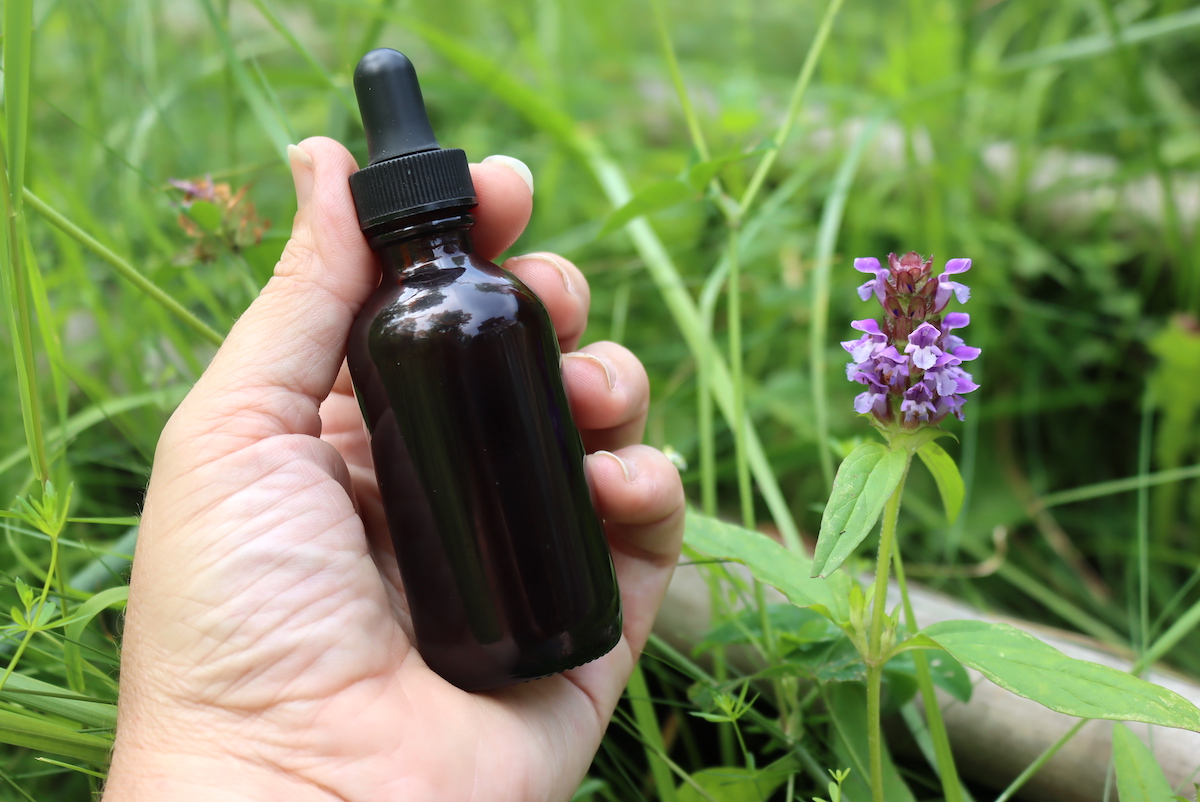
Self Heal doesn’t get much recognition today, but it was once a highly valued herb.
As the name Self Heal and other common names like Heal All, Woundwort, and Carpenter’s Herb suggest, it was once the go-to herb for cleaning cuts and minor wounds as well as promoting tissue healing and repair.
Its lesser-known use is as a herbal immune booster, used as a natural remedy for colds and flu. Self Heal was once a common choice for helping people fight off colds, flu, and other viral infections.
The great thing about Self Heal is that you can find it nearly anywhere. It frequently grows in lawns and gardens; its purple flower spires poking up all summer long. You can preserve the summer flowers and leaves in a tincture and have it on hand throughout the year, as it grows when the sun shines…but colds and flus tend to strike when it’s under a blanket of snow in the winter.
Self heal is easy to identify, and it’s a common yard weed with purple flowers that grows in all 50 states (and worldwide).
If you don’t find any Self Heal near you, you can also order seeds. Some folks grow this species as a wildflower, groundcover, or ornamental. Just know that it can get a little weedy and tends to self-seed if you don’t deadhead it.
It can be a great groundcover choice around berry bushes or fruit trees. The beautiful purple flowers are a favorite with bees and beneficial insects, and it can help suppress less desirable weeds.
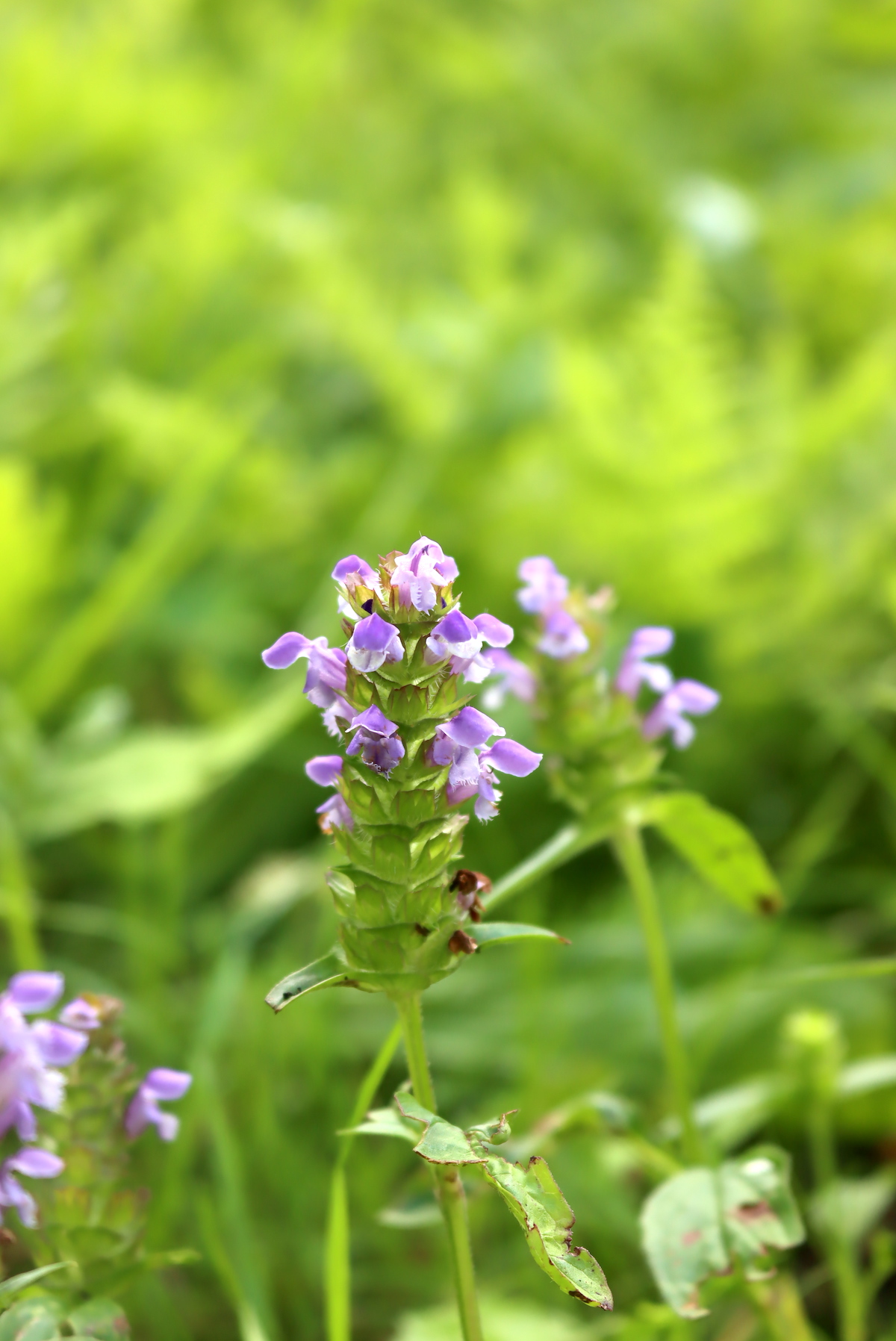
Self Heal Tincture Uses
Herbalists use self heal tinctures both topically and internally to treat a variety of ailments.
Topically, self heal tinctures is used for:
- Cleaning Cuts and Minor Wounds
- Promoting Tissue Healing and Repair
- Reducing Inflammation
Internally, self heal tincture is used to:
- Boost the immune system
- Treat colds, flu, and other viral infections (through immune support)
- Treat internal inflammation, soreness, and infections of the mouth and throat
- Treat internal wounds from IBS, Crohn’s, and Ulcerative Colitis
Additionally, the herb is currently being investigated for its potential:
- Anti-Cancer Properties
- Diabetes Treatment
In these cases, research is ongoing, and more work is needed to establish whether or not the benefits are scientifically significant.
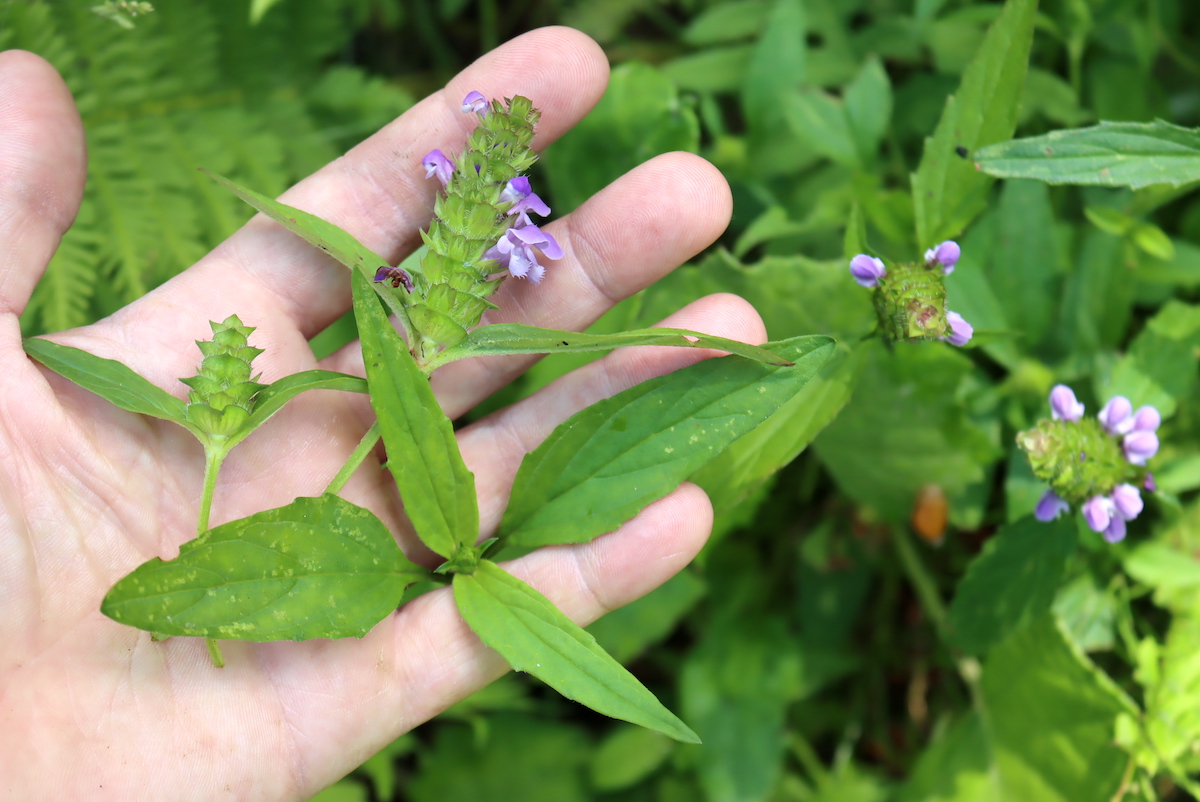
Benefits of Self Heal Tincture
With a name like self heal, it’s unsurprising that this traditional medicine is recognized for its healing abilities all over the world, from the Chinese and Germans to the Iroquois and Cherokee, to heal a wide range of diseases and wounds. Historically, self heal was taken for a variety of ailments, including fever, wounds, rashes, and gastrointestinal issues—it was also used as an eyewash and to treat hemorrhoids.
Self Heal may be best known for its external use on cuts and wounds. Thankfully, the tincture acts similarly and can help promote healing externally. It also works on internal wounds, such as damage or inflammation in the gut from conditions like IBS, Crohn’s, and Ulcerative Colitis. One study found that Self Heal’s anti-inflammatory activity effectively reduced intestinal inflammation in mice with Colitis.
Additionally, herbalists traditionally used Self Heal to treat inflammation, soreness, and infections in the mouth and throat. Prunella, part of Self Heal’s scientific name, comes from Brunella, which is derived from “die Bräune,” the German word for a type of throat inflammation called quinsy.
Self Heal’s antiviral properties have also been well-researched. Taken internally, Self Heal Tincture can help the body fight viral infections like colds, flu, and herpes.
Practitioners of traditional Chinese medicine also use Self Heal to treat diabetes. It’s still widely used in today’s folk medicine, but it has also been the focus of more modern research. An interesting study found that Self Heal extract significantly reduced and suppressed blood glucose levels in diabetic mice.
Herbalists and doctors have also used Self Heal to help treat and prevent cancer often in combination with modern practices or other herbs. One study gave Self Heal or a placebo to random groups of patients with precancerous lesions of the esophagus. Of the 300 patients receiving Self Heal, 64.4% responded to the treatment, compared with 22.8% in the placebo group.
Research on the medicinal properties of self heal is still in the early stages, but it has recently been the subject of animal studies that look at its effect on glucose levels and gut microbiota. Similarly, there have been several in vitro studies that show this humble weed has possible anti-tumor, anti-bacterial, antioxidant, and anti-viral benefits.
Self Heal tincture dosages often vary depending on the person and ailment. However, herbalists generally recommend 30 to 50 drops (usually one dropper full or about ⅛ of a teaspoon) up to three times daily.
Parts Used for Tincture
Making a Self Heal tincture is easy, but you need to gather the plant at the right time. Self Heal is most potent when in flower. Harvesting your herbs in the morning after the dew has dried but before the day has gotten hot is ideal.
Gather the whole plant, including the stems, leaves, and flowers, for the tincture. Look for plants with flowers that are still fresh and purple. Discard any stems where the flowers have browned.
Roughly chop your Self Heal into pieces about 1 inch long or less. This will help increase the surface area for the tincture process.
If fresh Self Heal isn’t available to you, you can order dried Self Heal for this tincture. Grinding or crushing your dried Self Heal will help increase the surface area for the tincture.

How to Make Self Heal Tincture
To make a Self Heal tincture, you’ll need the following ingredients and equipment:
- Chopped Fresh Self Heal
- Vodka* (or any other palatable alcohol that’s at least 80 proof/40 percent — there’s no need to splurge here. I always use Smirnoff because it’s inexpensive and has a neutral taste)**
- One-pint mason jar with lid (amber glass is ideal, but as long as you keep the tincture away from light at all times, it won’t make a difference)
- Funnel
- Cheesecloth
- Fine mesh sieve
- Amber glass tincture bottles (with dropper)
*The Herbal Academy recommends 80-proof alcohol for fresh herbs, but you can use 60-proof if you’re working with dried herbs.
**Never use isopropyl/rubbing alcohol for tinctures (or any other remedy you plan on ingesting). Even in small amounts, this type of alcohol is toxic and meant for external applications only.
To make the tincture, fill a jar about 3/4 full with fresh Self Heal (or about halfway full with dried Self Heal).
Cover the chopped Self Heal with vodka or whichever alcohol you’ve chosen so that it’s about 1 inch above the top of the herbs, and seal the jar with its lid.
Place your jar in a cool dark place, but be sure to take it our and give it a gentle shake every few days. Shaking your tincture daily is ideal, but they’re generally very forgiving so every couple of days will do just fine. Ensure the alcohol level remains above the top of the herbs, and add a bit if some has evaporated.
After about 4 to 6 weeks, it’s time to decant the tincture.
To do this, line a funnel with a few layers of cheesecloth. Carefully strain the tincture into small amber glass dropper bottles. Squeeze your cheesecloth bundle of Self Heal thoroughly to ensure all the liquid is expelled.
After decanting your tincture, label the tincture bottles with the date and suggested dosages (I use a small piece of masking tape and a marker; it peels off easily when I’m ready to use the bottle for something else).
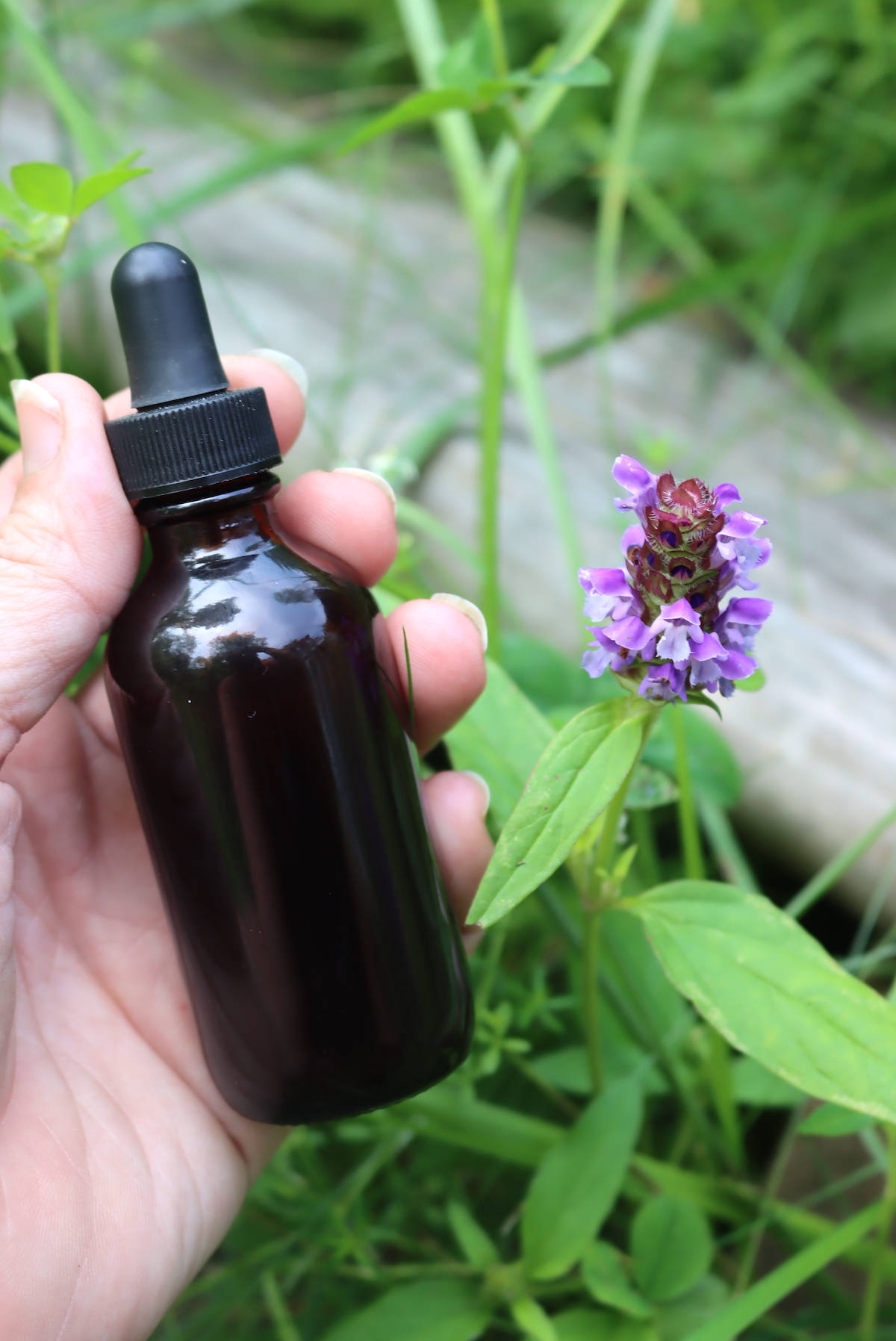
Self Heal Tincture Dosage
I’d suggest consulting a clinical herbalist for an exact dosage specific to your body and needs.
Generally, herbalists recommend 30 to 50 drops (usually one dropper full or about ⅛ of a teaspoon) up to 3 times daily.
If taking the plain tincture doesn’t work for you, you can also experiment with adding a dropper full to a glass of water, tea, or fruit juice to make it more palatable.
Self Heal Formulations
Self Heal is often used in combination with other herbs that have antibacterial and immune-boosting properties. To treat colds and flu, taking your Self Heal Tincture with echinacea tincture, astragalus root tincture, or elderberry tincture can help support your immune system. When using Self Heal to treat intestinal issues like IBS, soothing preparations like peppermint, ginger, or chamomile tincture make excellent companions.
If you’re interested in the science behind combining herbs to enhance their effectiveness, I’d recommend taking this online course in Mastering Herbal Formulations from the Herbal Academy. It covers the science of blending herbs into homemade formulations in detail.
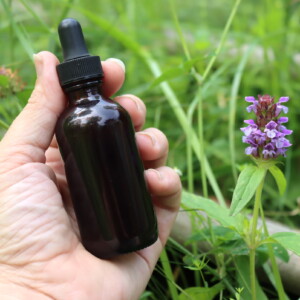
Self Heal Tincture
Equipment
Ingredients
- Fresh or Dried Self Heal Herbal Material
- Neutral Spirit such as vodka*
Instructions
- Start by gathering fresh self-heal (Prunella vulgaris) leaves and flowers. If you're using fresh self-heal, fill a clean mason jar about halfway with the plant material. If you’re using dried self-heal, you’ll need to fill the jar about one-third of the way. Fresh herbs tend to release moisture during the extraction, so you don't want to overpack the jar.
- Once the jar is packed, pour your choice of high-proof alcohol over the self-heal, completely submerging the plant material. Vodka is the most commonly used alcohol for tinctures due to its neutral flavor, but you can also use brandy or rum. Ensure the alcohol level is at least 2 inches above the plant material to prevent any parts from being exposed to air, which could lead to mold.
- Secure the jar with a tight-fitting lid and give it a gentle shake to mix the plant material with the alcohol. Place the jar in a cool, dark area, such as a cupboard or pantry, for the extraction to begin. Over the next few weeks, the alcohol will begin drawing out the medicinal properties from the self-heal.
- For the best results, shake the jar every 1 to 2 days. This helps agitate the plant material and ensures that the alcohol is evenly distributed, extracting the beneficial compounds. If you're using fresh self-heal, the plant material may float, so you’ll need to check occasionally to make sure it stays submerged. If necessary, add more alcohol to keep the plant fully covered.
- After 4 to 6 weeks of steeping, strain the tincture through a fine mesh strainer or cheesecloth into a clean dark glass bottle. Be sure to press the plant material to squeeze out all the liquid. You can discard the spent herb once it's been strained.
- Label the bottle with the date, the contents (Self-Heal Tincture), and any notes about dosage or usage. Store your tincture in a cool, dark place away from sunlight. The tincture will last for several years if stored properly.
Notes
Disclaimer on Homemade Herbal Remedies
I’ve been foraging wild medicines and treating my family with herbal remedies for the past 20 years, but I’m self-taught. Be aware that I am not a clinical herbalist, and this is based on my own research and personal experience using medicinal plants. I do not claim to have the experience that’d qualify me to advise you on your health, and I’m only providing this as a reference to encourage a broader interest in medicinal plants.
Please use this as a jumping-off point, but always do your own research and verify anything you read with multiple sources.
It’s always possible to have an adverse reaction to any medicinal herb, and plenty of people are allergic to even gentle herbs like chamomile. Always consult your doctor or a certified herbalist before trying any new medicinal plant. Often, they can have unintended reactions in combination with other herbs and supplements, and many herbs have side effects even when they are effective for their intended purpose.
If you are seriously interested in herbal medicine, I’d suggest investing in a course in herbal medicine, and I’d recommend any of the online courses put out by the Herbal Academy of New England. Specifically, the introduction to herbal medicine course and the family herbalist group of courses.
They also have a mushroom course, covering both medicinal and edible mushrooms, and a Botany and Wildcrafting Course. I’ve taken both and they’re informative, inspiring, and artfully presented.
Herbal Tinctures
Interested in making other homemade herbal tinctures?
- Yarrow Tincture
- Chickweed Tincture
- Spilanthes Tincture
- Burdock Tincture
- Marshmallow Tincture
- Echinacea Tincture
Herbal Medicine Making
Herbal medicines don’t stop at tinctures! Learn how to make more homemade medicine…

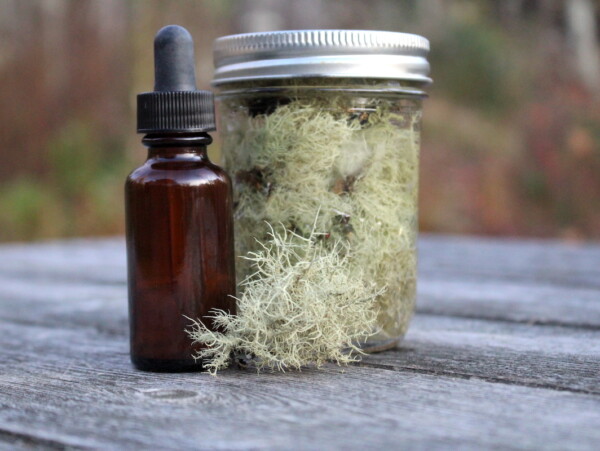
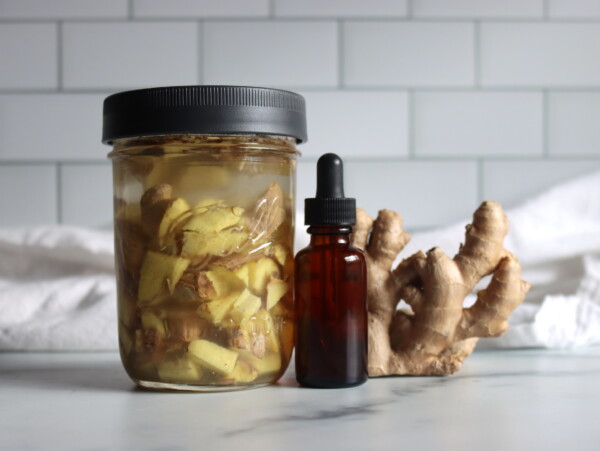
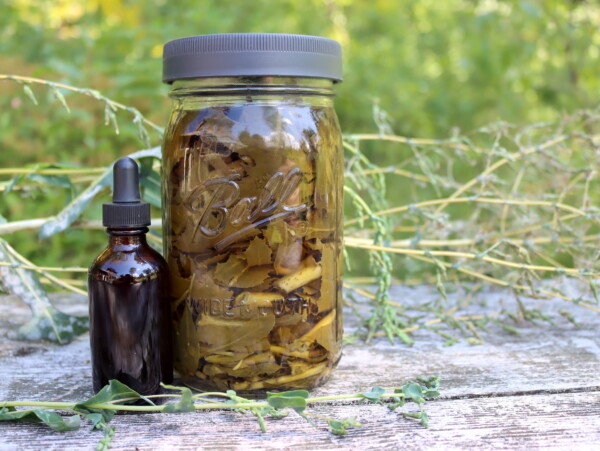
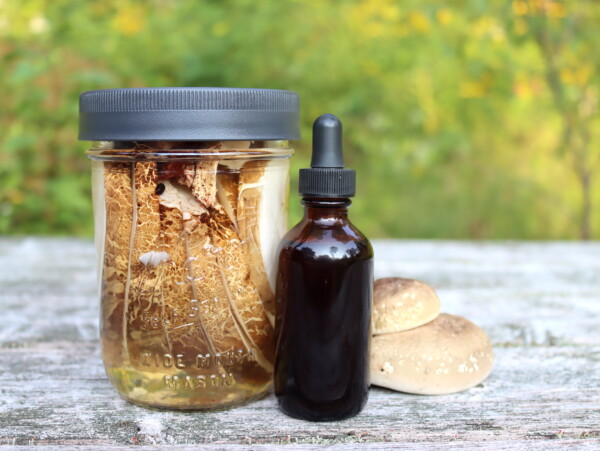
Thanks for this information!
I’m curious about how to choose which tincture to use when the properties overlap. For example, I currently use yarrow or oregon grape tincture for some of the uses listed here. How would I know when it would be better to take a self heal tincture instead or is it best to use both/all together?
Herbalism is both an art and a science. A lot of it depends on the herb and how that herb helps with a particular problem. Understanding how the body works and how different herbal actions affect the body is key. The other key thing is trial and error. Trying different herbs and different combinations of the herbs and then testing them out is really one of the best ways to find the answer because each individual person is different as is each individual problem.
Hey Ashley, if there is one thing you could add to your home. Let me start over. We live in rural Iowa, I’m 57, and we’re just lost our house to fire. I’m blessed to have had great insurance. Yes it was a total loss. I Mourn my herb, and essential oils and books the most. So what is something I can add into the rebuild, that may help me be more efficient and willing to forage, store, etc. like I enjoy making healing and cooking oils with coconut and castor oil. Either using essential oils, or as simple as oregano, Basil, And thyme. Thank you in advance for your input, Winnie Tuman
I’m so sorry for the loss of your home. If you’re able, it would be great to build a room that could be used specifically for storing and creating all of your herbal preparations. You could have shelves for your books and a work space along with shelves for storage.